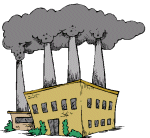|
Chimneys & Stacks

Although media attention has shifted towards other environmental issues such as global warming, acid deposition continues to be a problem at the beginning of the 21st century. In fact, acid rain is not a new problem at all. It dates from the middle of the 19th century when a Scottish chemist, Robert Angus Smith, began to study the effect of air pollution in Manchester, UK, and used the term acid rain to describe his findings. What is very new is the scale of the problem. In Smith's time, acid rain fell both in towns and cities and downwind from them, but now, the pollution is spread far and wide, within and between nations. It has now become an international or transboundary problem.
In December 1952 the Great London Smog accounted for over 4,000 deaths due to high levels of smoke and sulphur dioxide pollution. To prevent such a catastrophe ever occurring again, the UK Government passed two Clean Air Acts, the first in 1956 and the second in 1968. The Clean Air Act of 1968 brought in the basic principle for the use of tall chimneys or stacks for industries burning solid, liquid or gaseous fossil fuels. At the time of this legislation it was recognised that smoke pollution could be controlled, but that sulphur dioxide removal was generally impracticable. Hence, the higher the chimney, the better the dispersal of the air pollution.
Urban air quality improved following the Clean Air Acts. Research into and monitoring of airborne pollutants reinforced the view that tall chimneys ensured adequate dispersion in the atmosphere, reducing significantly the amount of sulphur dioxide and nitrogen oxides pollution at ground level. However, concern grew regarding the eventual fate in the atmosphere of the pollution emitted. Aircraft measurements in the 1970s revealed that as much as 70% of sulphur dioxide emitted in the UK was leaving the country. It became clear that this pollution was the primary cause of the acidification of thousands of freshwater lakes in Scandinavia, and the damage to hundreds of thousands of trees.
Whilst chimneys and stacks are still used today to disperse pollution from fossil fuel burning, sulphur dioxide and nitrogen oxides pollution from power stations and industry has been falling since the 1990s as a consequence of improved emission control technology in response to international agreements on transboundary pollution negotiated in the 1970s and 1980s.
|

